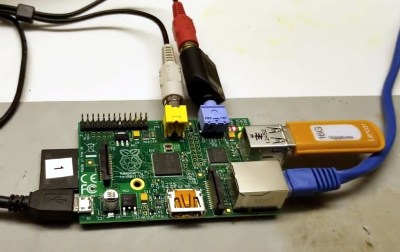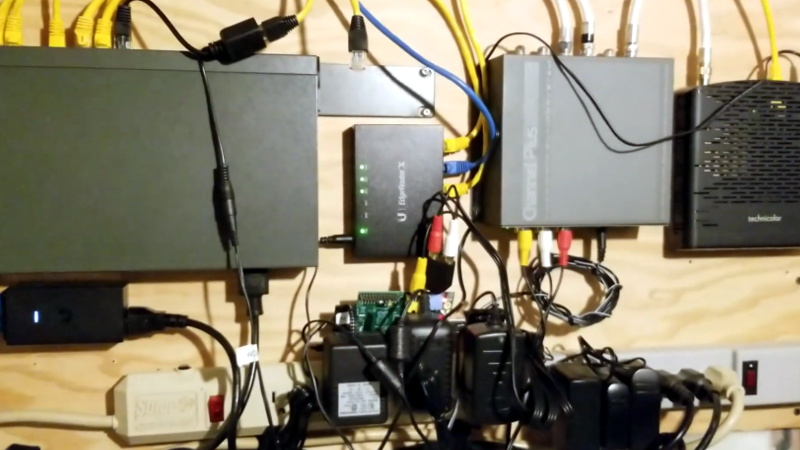Commercial-free video on demand was every couch potato’s dream for decades, and now we’ve got it. But nostalgia has a funny way of making some folks miss the old days, even if we know it’s technically be a step backwards. Wanting to recreate the TV watching experience circa 1998, [probnot] has come up with a way to run his very own television channel.
With the Raspberry Pi and a digital modulator, he’s got the only house on the block that’s wired to show The Simpsons all day. He has absolutely no control over which episode plays next, he can’t pause it, and its in presented in standard definition (a nightmare for anyone who grew up in the Netflix era) but a familiar viewing experience for the rest of us.

The key to this project is the Channel Plus Model 3025 modulator. It takes the feed from the antenna and mixes in two composite video sources on user-defined channels. All [probnot] had to do was find a channel that wouldn’t interfere with any of the over-the-air stations. The modulator has been spliced into the house’s coax wiring, so any TV connected to the wall can get in on the action. There’s no special setup required: when he wants to watch The Simpsons he just tunes the nearest TV to the appropriate channel.
Providing the video for the modulator is a Raspberry Pi, specifically, the original model that featured composite video output. While the first generation Pi is a bit long in the tooth these days, playing standard definition video is certainly within its capabilities. With a USB flash drive filled with a few hundred episodes and a bit of scripting it’s able to deliver a never-ending stream direct from Springfield. There’s still that second channel available on the modulator as well, which we’re thinking could be perfect for Seinfeld or maybe The X-Files.
Interestingly, this isn’t the first time we’ve seen a Raspberry Pi used to provide a never-ending stream of The Simpsons. But compared to previous attempts which had to be directly connected to the TV, we like the idea of using the modulator and creating a more authentic experience.
















The next step to wouldfurther the nostalgia would be to add back in commercial breaks from 1998.
Ads went from about 9 minutes per hour in the 1960s to 22 minutes per hour in 2016. Yet broadcasters are flabbergasted why people cut the cord or pirate shows.
That would work be well in my place. The original owner wired multiple coax runs to each room and via splinters and amplifiers you can feed an RF signal from any room and it gets distributed to all the other rooms along with the antenna feed.
Along with a whole house audio system it would have been quiet flash back in the early 90s when it was built
Our installer created a similar setup for a security system, every room in our home has two coax outs (one for security, one for cable) and one input that goes to a distribution board to connect it to all other rooms, as well as the security system if desired.
“the original model that featured composite video output” – every raspberry pi to date features composite video out.
Only the first model had an actual composite jack– every other raspi makes you buy a dopey cable…
Except for the zero which has an unpopulated header instead
Okay, let’s clarify, “the original model that featured composite video output on a dedicated connector”… since all subsequent models used the 4th contact on a TRRS connector.
You could get TeeFax running on it too, and have an almost ‘proper’ TV station ;)
The rest of the world has never heard of Teletext.
RPi’s are cool. To bad their online community is toxic.
The Facebook and Reddit groups are just the usual “How I make a robot?!” plus “”I slightly changed the color of this case”, mixed in with a few cool projects.
Nothing worse than your average tech community from what I’ve seen. Are the official forums full of bad stuff?
I don’t do facebook or reddit for obvious reasons, but I hoped that the forum run by the foundation itself was a bit more useful. Instead it’s yet another tribal circlejerk with double standards. I found it to be less then useful and when trying to be useful, the only time the “experts” would join in was to correct some trivial mistake to dismiss a suggestion out of hand. Shame, I do consider the “community” part of the product and that part is.. underwhelming.
It’s very nice when people share a cool project using a pi (or not). And it’s very nice when people share entry level modding/hacking as well, so anyone can get on board. Your comment is a dime or less a dozen and adds nothing of value to any kind of community. Have a less bitter day.
Urgg… Hand me a bucket please….
Of course it is. Don’t you know that everything not exclusively female PoC is these days? Grow up.
What are you blathering about?
If this could be updated to do ATSC, then you can broadcast on an open channel in HD. This would be useful to push security feeds to any TV in the house for example. Now will have to look at setting up a ATSC broadcast system on the cheap.
A fl2k would certainly have the bandwidth to do it, not sure how much processing power it would take to generate an ATSC stream in real time.
A pi might manage a mpeg2 standard definition stream in real time. Even if the CPU was suddenly eleventy times faster though you run into storage and i/o bandwidth issues quick on Pis.
I actually looked at that, but the price of ATSC/QAM modulators is stupid expensive. This modulator was $15 vs a couple hundred for an HD version.
once i wanted to implement a 24 hour jimi hendrix radio :)
I have so many Grateful Dead albums that it would take days to play them all.
And I don’t even have live recordings,just what the Dead have released.
Absolutely perfect for dementia care homes to implement on the cheap.
Better than shuffle mode on a streaming stick? How?
I reckon a streaming stick and netflix/amazon prime (prime as it also gives the centre shipping for small purchases) is very common. But it doesn’t scale as well to multiple TVs spread over a dementia centre for example you would want each person to have a TV in their room/flat as well as the lounge areas.
Can distriubte the signal to all the TVs rather than having buying loads of Netflix accounts (max at 4 streaming per account) and loads of Streaming sticks.
How many sticks can connect to a single wifi router? Coax cable is cheaper – may already exist – than WLAN infrastructure which is overwise not required. <- otherwise streaming from the LAN would work wellish.
What kind of internet connection is required for this? Netflix uses at least 0.5mbps per stream. Feels like wasted bandwidth when really you just want to play the same thing on loop.
Also don't have to constantly click "Yes I am watching".
Most people with dementia will be able to use a simple TV to flip channels but will struggle with tech that wasn't around when they were a kid like the Netflix UI which changes at least once per year.
While a streaming stick will let you play probably a show's episodes end to end but this would allow you to construct entire day's worth of TV.
Missed opportunity- the USB drive label should have been BORT instead of BERT! :)
My home server consists of a snapraid + mergerfs setup. The resulting pool of data drives is labeled and mounted as milPool…
They were all out of Bort USB drives in the gift shop.
Also using snapraid and mergerfs here. Works very well. Not sure if I would want to burn one EIA for one show, but that would be cool. On the streaming side there are projects to randomize what’s playing on an iptv stream and then you just tune to that stream. It’s a guessing game as to what’s coming on next!
Would prefer if he used an NTSC transmitter but still he’s really embiggened that project..
“and its in presented in standard definition (a nightmare for anyone who grew up in the Netflix era)”
Widescreen Simpsons is an afront to the show. It’s the equivalent of when movies were chopped up to fit on 4:3 televisions.
20 bucks says Fox/Disney will sue him for Copyright Infringement and/or Pirated Distribution within a month…
Assuming he purchased the content in a lawful manner and his stream remains within the confines of his property and he seeks no compensation for its consumption one would find themselves in the sheltered harbor of Fair Use.
This is a horror story, right? Imagine being subjected to the Simson longer than 30 Minutes…..
Sadly, the amp is extinct as of March 2020; maybe the Corona virus killed it. Then again, I think I have an RF modulator somewhere, outputs on channel 2 or 3, and I can feed that into a splitter. An old DVD or VHS player would do the job.
Not sure why I need it though, when our computers are used more than TVs.
DVDs unless they had recording capability likely only have AV out, not AV in, as some VCRs would.
24 Hours day , seven days a week looking at the Waterboarding for the brain Simsons – what a cruel and inhuman torture. Have you not anything better to do?
Later this year I created a raspberry pi TV tuner project including a web-based remote control. I made this to watch TV on my sega game gear. You can check it out here: https://www.youtube.com/watch?v=cm9PoflKxNo
This is some sort of joke,right?